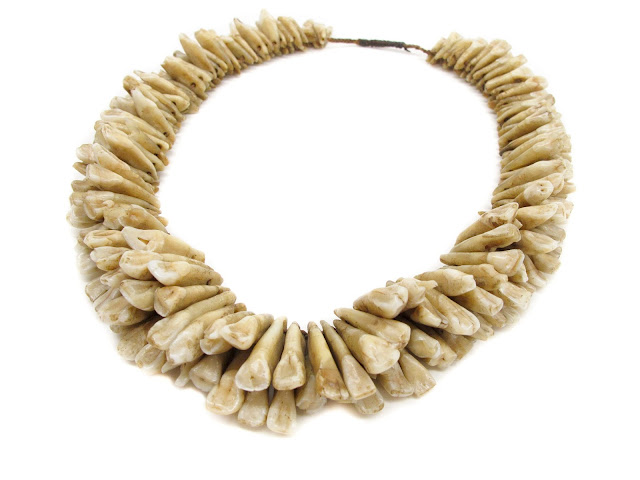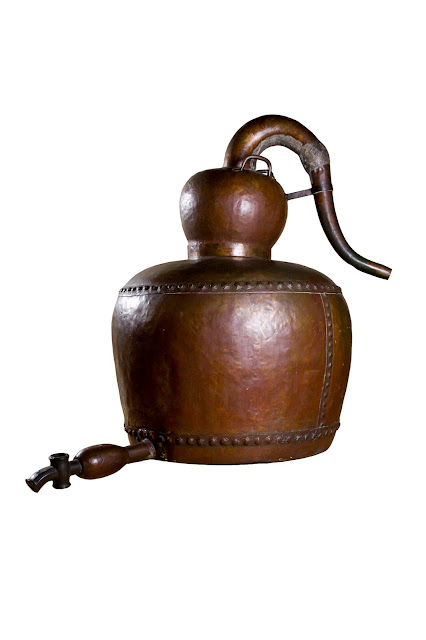 |
|
Human Tooth Necklace (Vuasagale),18th to19th Century
Fiji, Polynesia, Oceania
Human teeth, twine and fiber; 7 in.
2010.2.1
Jordan Community Trust Purchase
|
Throughout the Pacific region, teeth from a variety of animals were used for trade, personal adornment, and as status symbols. This necklace is strung on a brown fibrous strand with 203 human incisor, molar, and canine teeth from about 60 to 100 individuals. Documentation suggests that these teeth were claimed by warriors as trophies after a kill. Talk about fighting tooth and nail.
 |
|
Tomb Demon, Warring States Period to Western Han Dynasty (475 B.C.-9 A.D.)
Han people; China
Wood and paint; 28 x 25 1/2 in.
97.122.1
Gift of Dr. Ellyn Shander, M.D.
|
This wooden figure carved with prominent antlers represents a tomb spirit or tomb guardian. The purpose of this horned figure was to protect the dead and exorcise intrusive demon spirits. Like this one, most tomb guardians depicted fantastic creatures with large eyes and protruding tongues!
 |
|
Clamshell Money, c. 500-1700 A.D.
Channel Island culture; Southern California Coast
Shell; 98 x ½ in.
9594
Gift of the Irvine Foundation
|
Long before puka shells were fashionable accessories in this era, thinly carved shell beads were a common form of currency used by Native Americans in the Southern California region. Strung together on a long string, the value was determined by the size and polish of the shells.
 |
|
Brandy Still, c. 1776-1831
Southern California
Copper; 53 x 36 in.
2810
Gift of Mr. and Mrs. John Forster
|
If you fancied a cup of brandy during the late 1800s, you would have liked to be friends with Don Juan. This old copper brandy still belonged to early California landowner Don Juan Forster (an Englishman who became a Mexican citizen) who brought this - Southern California's first still. Don Juan had a reputation for producing fine liquors such as brandy, which was produced by both the missions and early rancheros for exchange with foreign traders. Brandy was also commonly used during this time for medicinal purposes.
 |
|
Female Ancestor Figure (Tau Tau), c.1980
Sa'Dan Toraja culture; Sulawesi Island, South Sulawesi, Indonesia, Asia
Wood, paint, textile, hair and glass; 58 x 19 x 21
2009.13.1
Bowers Museum Purchase
|
This carved woman is endearingly called Mama Tau-tau among Bowers staff, though others feel that her realistic features are nightmare-inducing. Tau-tau from the Sa'Dan Toraja culture in Indonesia are sculpted to represent the deceased and the figures play a central role in elaborate funerals. To create a life-like appearance, the artists used real human hair and dressed the figure with the deceased’s favorite clothes and jewelry. After the funeral, the Tau-tau would be placed on a rock cliff with other carved effigies so that they could oversee the villages.
 |
|
Sarcophagus (Erong), early 19th century
Torajan culture; Sulawesi, Indonesia
wood; 46 1/2 X 37 X 104 in.
2004.42.1
Gift of Mr. Larry Camp
|
Forget digging holes; Erongs used to hold the remains of the deceased in Sulawesi are not buried in the ground but placed into a cliffside cavity. This erong resembles a water buffalo - a popular erong form of wealthy landowners. It has detachable horns and a lid to represent a style of roof in the Torajan culture. The type of erong was a symbol of status, where nobility created theirs in a shape of a house boat. This sarcophagus is not hard to find in the museum, so if you still have not seen it, you were looking in the erong places.
 |
|
Ritual Magic Bag, 20th Century
Central Highlands area, Chimbu Province, Papua New Guinea, Melanesia
Fiber, various animal bone, leaves and stone; 13 7/8 x 11 1/2 x 8 7/8 in.
2003.43.17
Anonymous Gift
|
Do you believe in magic? In the Melanesian culture of Papua New Guinea, traditional magic bags are used by powerful men, sorcerers, and healers for the business of healing or warding off evil spirits among villagers. This magic bag was created using assorted animal bones, stones, and fiber netting to hold precious talismans, healing stones, leaves, or other “magical” substances. In certain regions of New Guinea, the belief of sorcery continues to be very strong.
 |
|
Peaceful-Wrathful Deities Mandala, 2003
Artist Shashi Dhoj Tulachan, Nepal
Natural mineral pigments
L.2012.25.3
Loan courtesy of Gayle and Edward P. Roski
|
This mandala is a thangka painting created for the purpose of depicting teachings of the Buddhist religion. These murals were completed by a Tibetan monk named Shashi Dhoj Tulachan. Peaceful-Wrathful Deities Mandala illustrates the wrathful and fearsome forms of deities called Heruka, which in Tibetan translates to blood drinker. In their wrathful form, the deities are depicted as fearsome figures, such as Yamantaka, who is known as the conqueror of death. This mandala shows incredible detail when displaying the deities adorned with skulls, bursts of flames, and severed heads. You have to get a closer look to appreciate all of the colorful details in this action-packed masterpiece.
 |
|
Over Modeled Skull, 20th Century
Middle Sepik River region, East Sepik Province, Papua New Guinea, Melanesia
Human skull, clay, pigment, shell, and human hair; 5 7/8 x 5 7/8 x 7 15/16 in.
99.43.9
Donated by Rear Admiral Ralph and Sara Garrison
|
This haunting over-modeled human skull is a version of an ancestral portrait created as a funerary ritual object. Using clay, pigment, shells, and human hair, a skull was transformed from its cleaned out skeletal form into a realistic likeness of the deceased. This was done by a craftsman after the body was decomposed after a period of time. Cultures in the South Pacific Islands used this technique as forms of effigy for the dead, which were later carried and displayed in the village to be remembered and mourned.
 |
|
Scenes of California, 1932
Mural painting on ceiling
Martin Syversten (Norwegian-born American, 1874-1947) and Karl Schabell (American, b?-d?)
Bowers Museum Flour Family Gallery
|
You have to look up to see one of the biggest treasures of the Bowers Museum. Painted on the ceiling are themes of historic California with symbols and icons of the state such as the grizzly bear, Mission San Juan Capistrano, and covered wagons. The artist Martin Syversten and his assistant Karl Schabell were given room and board at a hotel nearby during the project to finish this coffered ceiling. It took them six months to complete and they finished in time for the museum dedication on December 1, 1932. Since it was completed during the Depression and the Bowers Museum did not open until 1936, instead of receiving a bonus they were promised at the end, they were only granted ten cents on the dollar about six years later. If you look closely at the mural, you will notice that the California seal painted by the artist differs from the official design. If you look even harder, you might find gold.
Text and images may be under copyright. Please contact Collection Department for permission to use. Information subject to change upon further research.









Comments 2
Good post.
Wow, This is such an interesting and informational post, Thanks for sharing this post with us, I really like your post, and Keep sharing this kind of informational post with us.